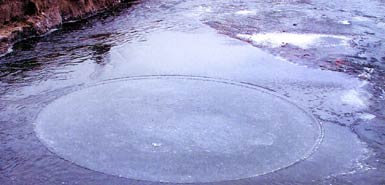
© South West News ServicePerfect ice circle rotating in the River Otter
An unusual rotating ice circle, normally found in the cooler rivers of Scandinavia or North America, has formed in the UK waterways.
The cause of the rare phenomenon is unclear, with very little scientific evidence available to explain the formation of the discs. UFO-enthusiasts claim that, like crop circles, the perfect discs are created by visiting aliens, but scientists believe the extreme cold weather combined with an unusual current is the more likely reason.
The 10ft disc was seen by a rambler on the River Otter in Devon, who estimated that it was spinning through 360 degrees every four minutes.
The Meteorological Office said today that they could not explain why the ice circle appeared last week.
"We're kind of a bit stumped to be honest," a spokesman said. "Our best guess, and it is a guess, would be that it was formed by some kind of a circular eddy set up in the river. We have not seen anything like this before and we've no idea why they seem to be more common in Scandinavia."
The disc was spotted on January 7 as temperatures in southern England reached as low as minus 10C. The freeze caused unusual behaviour amongst British wildlife, which is ill prepared for such conditions. The rare cold snap may also have caused the ice formation, which has been recently recorded and investigated in the US and Sweden.
Mystery has surrounded the discs since they were first described as long ago as the nineteenth century. A drawing of an ice circle was published in the
Scientific American in 1895.
Illustrated London News also catalogued one that formed near Toronto in 1930 under the headline "Jack Frost describes a circle".
The lack of a clear explanation from the scientific community allowed conspiracy theorists to add the ice circles to the annals of "unexplained phenomena" until 1993 when MIT attempted to end the debate.
Ice circles began to form on the Charles River in Cambridge, Massachusetts, which runs through the MIT campus, prompting scientists at the university to study their formation.
David Ricks, an ocean engineering graduate, helped systematically rule out effluent from submerged pipes, down draughts from helicopters, alien activity, bubbles from decomposition and underwater springs.
He concluded that eddies from the Harvard bridge caused parts of the sheet ice to break away and the movement of the ice created circular holes which were filled by further ice formation. Other theories suggest that slow moving rivers can create eddies which spin the ice until it takes on a circular shape.
Photographs of the phenomenon emerged from Russia recently, and it appears that the discs are quite common in Norway as well as Sweden, where they have been recorded on the River Ljusnan measuring up to 200m wide, as well as on the River Pite and on Lake Hotagssjon.

Reader Comments
to our Newsletter